
Anthony Salvin
Encyclopedia
Anthony Salvin was an English architect
. He gained a reputation as an expert on medieval
buildings and applied this expertise to his new buildings and his restorations. He restored castles and country houses
, and built a number of new houses and churches.
, as the only child of General Anthony Salvin, a soldier, and his second wife Elizabeth (Eliza) Mills. He was educated at Durham School and then became a pupil of John Paterson of Edinburgh
while he was working on the restoration of Brancepeth Castle
in County Durham. In 1821 Salvin moved to London. He had an introduction to Sir John Soane
but did not enter his office. According to his nephew he entered the office of John Nash
. In 1824 he was elected as a fellow of the Society of Antiquaries
. Soon after this he went on a sketching tour of Great Britain. On 26 July 1826 he married his cousin, Anne Andrews Nesfield. With her he had six children, two of whom died in infancy.
for Robert William Newman. This was designed in the Tudor
style to a symmetrical plan. It was adapted from a plan by Charles Fowler
and this placed restrictions on his design. His next design was for Moreby Hall in the East Riding of Yorkshire
for Henry Preston where he was free to develop a complete design in the Tudor style, again on a symmetrical plan. At Scotney Castle
in Kent
he designed for Edward Hussey an asymmetrical design in the Tudor style. In 1831 Salvin embarked on what is considered to be his most important early domestic work at Harlaxton Manor
in Lincolnshire
for Gregory Gregory. Salvin's design combined elements from Montacute House
in Somerset
and Hengrave Hall
in Suffolk
. However before the building was complete, Salvin was replaced as architect by William Burn
. In 1835 Salvin spent five weeks in Germany.
In 1836 Salvin entered a design in Tudor style in the competition for the new Palace of Westminster
which had possibly been inspired by his visit to Germany. However this was unsuccessful, as was his entry for the competition to design the Ashmolean Museum
in Oxford
. He won the competition for the design of the Carlton Club
in Pall Mall, London
but the club decided not to proceed with his plan. After losing a further competition, this time to design the Army and Navy Club
, Salvin did not enter any more competitions.
in Staffordshire
for Ralph Sneyd, and Thoresby Hall
in Nottinghamshire
for Sydney Pierrepont, 3rd Earl Manvers
. There were exceptions, including Penoyre in Brecon
, an Italianate
villa-style house for Colonel John Lloyd Vaughan Watkins
and Oxon Hoath
in West Peckham
, Kent
in the French Châteauesque
style for Sir William Geary.
A major part of Salvin's work was to restore, refit and create castles. In 1835 he refaced Norwich Castle
, in 1844 he repaired the ruins of Newark Castle
and in 1845 he repaired the ruins of Carisbrook Castle. In the early 1840s the Queen's Gate of Caernarvon Castle collapsed and in 1844 Salvin repaired it and rebuilt some of the other masonry of the castle. In 1851 he surveyed the Beauchamp Tower of the Tower of London
and, after working on this he restored the Salt, the Wakefield and the White Towers and the Chapel of St Peter ad Vincula. Following this he was instructed by Prince Albert to carry out work on Windsor Castle
. This included replacing sash window
s with lancets
and mullion
ed windows and rebuilding the Clewer Tower. Salvin designed Peckforton Castle
in Cheshire
for John Tollemache, 1st Baron Tollemache
as a re-creation of a castle of the time of Edward I
. In 1852 he started work on the restoration of Alnwick Castle
in Northumberland
. This included replacing one of the towers with a larger tower, the Prudhoe Tower, creating a porte-cochère
, replacing windows and replanning the interior.
Salvin also restored and repaired 20 old churches and three cathedrals, and built 34 new churches. In the early 1840s he had worked on The Holy Sepulchre, Cambridge
, employing James Rattee
, and following this he was made an honorary member of the Cambridge Camden Society
. He arranged for the removal of buildings around the south transept of Norwich Cathedral
and reordered its choir. He also made alterations to Durham
and Wells Cathedral
s. In all he designed at least 34 new churches. Salvin's restorations were not to the liking of the Society for the Protection of Ancient Buildings
, particularly his removal of "unwanted fabric" from churches. Other work carried out by Salvin included rebuilding the keep of Durham Castle
for student accommodation, and work on restoring Trinity College, Cambridge
.
, Salvin suffered a stroke but recovered from it. In 1860 his wife died and he designed a new house for himself, Hawksfold at Fernhurst
, Sussex
. In 1863 he was awarded the royal gold medal of the Royal Institute of British Architects
and in 1879 he retired from formal practice. He died at Hawksfold in 1881 and was buried at Fernhurst. His estate was valued at over £78,000.
|
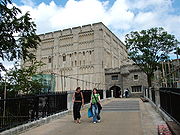
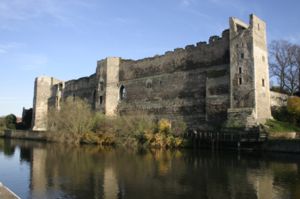
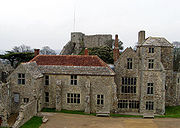
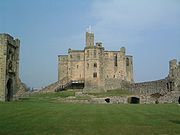
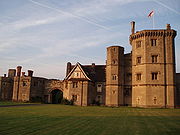
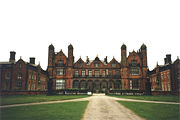
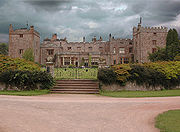
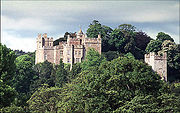

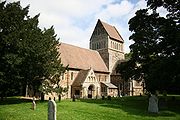
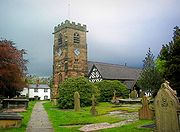
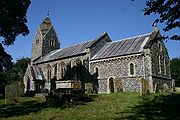
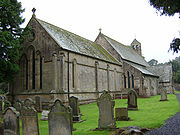
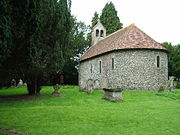
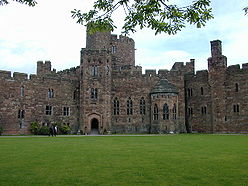
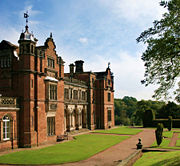
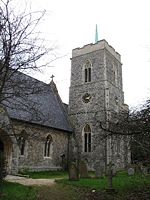
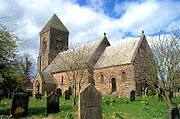
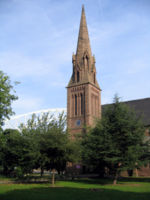
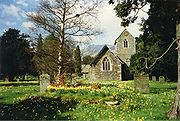
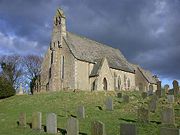
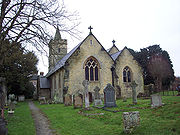
|}
Architect
An architect is a person trained in the planning, design and oversight of the construction of buildings. To practice architecture means to offer or render services in connection with the design and construction of a building, or group of buildings and the space within the site surrounding the...
. He gained a reputation as an expert on medieval
Middle Ages
The Middle Ages is a periodization of European history from the 5th century to the 15th century. The Middle Ages follows the fall of the Western Roman Empire in 476 and precedes the Early Modern Era. It is the middle period of a three-period division of Western history: Classic, Medieval and Modern...
buildings and applied this expertise to his new buildings and his restorations. He restored castles and country houses
English country house
The English country house is a large house or mansion in the English countryside. Such houses were often owned by individuals who also owned a London house. This allowed to them to spend time in the country and in the city—hence, for these people, the term distinguished between town and country...
, and built a number of new houses and churches.
Early life and training
He was born in Sunderland Bridge, County DurhamCounty Durham
County Durham is a ceremonial county and unitary district in north east England. The county town is Durham. The largest settlement in the ceremonial county is the town of Darlington...
, as the only child of General Anthony Salvin, a soldier, and his second wife Elizabeth (Eliza) Mills. He was educated at Durham School and then became a pupil of John Paterson of Edinburgh
Edinburgh
Edinburgh is the capital city of Scotland, the second largest city in Scotland, and the eighth most populous in the United Kingdom. The City of Edinburgh Council governs one of Scotland's 32 local government council areas. The council area includes urban Edinburgh and a rural area...
while he was working on the restoration of Brancepeth Castle
Brancepeth Castle
Brancepeth Castle is a castle in the village of Brancepeth in County Durham, England, some 5 miles south-west of the city of Durham . It is a Grade I listed building.-History:...
in County Durham. In 1821 Salvin moved to London. He had an introduction to Sir John Soane
John Soane
Sir John Soane, RA was an English architect who specialised in the Neo-Classical style. His architectural works are distinguished by their clean lines, massing of simple form, decisive detailing, careful proportions and skilful use of light sources...
but did not enter his office. According to his nephew he entered the office of John Nash
John Nash (architect)
John Nash was a British architect responsible for much of the layout of Regency London.-Biography:Born in Lambeth, London, the son of a Welsh millwright, Nash trained with the architect Sir Robert Taylor. He established his own practice in 1777, but his career was initially unsuccessful and...
. In 1824 he was elected as a fellow of the Society of Antiquaries
Society of Antiquaries of London
The Society of Antiquaries of London is a learned society "charged by its Royal Charter of 1751 with 'the encouragement, advancement and furtherance of the study and knowledge of the antiquities and history of this and other countries'." It is based at Burlington House, Piccadilly, London , and is...
. Soon after this he went on a sketching tour of Great Britain. On 26 July 1826 he married his cousin, Anne Andrews Nesfield. With her he had six children, two of whom died in infancy.
Early career
Salvin's first major commission was Mamhead Park in DevonDevon
Devon is a large county in southwestern England. The county is sometimes referred to as Devonshire, although the term is rarely used inside the county itself as the county has never been officially "shired", it often indicates a traditional or historical context.The county shares borders with...
for Robert William Newman. This was designed in the Tudor
Tudor style architecture
The Tudor architectural style is the final development of medieval architecture during the Tudor period and even beyond, for conservative college patrons...
style to a symmetrical plan. It was adapted from a plan by Charles Fowler
Charles Fowler
Charles Fowler , English architect, was born at Cullompton, Devon.After serving an apprenticeship of seven years with John Powning of Exeter, he went to London in 1814, and entered the office of David Laing, where he remained until he commenced practice for himself...
and this placed restrictions on his design. His next design was for Moreby Hall in the East Riding of Yorkshire
East Riding of Yorkshire
The East Riding of Yorkshire, or simply East Yorkshire, is a local government district with unitary authority status, and a ceremonial county of England. For ceremonial purposes the county also includes the city of Kingston upon Hull, which is a separate unitary authority...
for Henry Preston where he was free to develop a complete design in the Tudor style, again on a symmetrical plan. At Scotney Castle
Scotney Castle
Scotney Castle is an English country house with formal gardens south-east of Lamberhurst in the valley of the River Bewl in Kent, England. It belongs to the National Trust....
in Kent
Kent
Kent is a county in southeast England, and is one of the home counties. It borders East Sussex, Surrey and Greater London and has a defined boundary with Essex in the middle of the Thames Estuary. The ceremonial county boundaries of Kent include the shire county of Kent and the unitary borough of...
he designed for Edward Hussey an asymmetrical design in the Tudor style. In 1831 Salvin embarked on what is considered to be his most important early domestic work at Harlaxton Manor
Harlaxton Manor
Harlaxton Manor, built in 1837, is a manor house in Harlaxton, Lincolnshire, England. Its architecture, which combines elements of Jacobean and Elizabethan styles with symmetrical Baroque massing, renders the mansion unique among surviving Jacobethan manors....
in Lincolnshire
Lincolnshire
Lincolnshire is a county in the east of England. It borders Norfolk to the south east, Cambridgeshire to the south, Rutland to the south west, Leicestershire and Nottinghamshire to the west, South Yorkshire to the north west, and the East Riding of Yorkshire to the north. It also borders...
for Gregory Gregory. Salvin's design combined elements from Montacute House
Montacute House
Montacute House is a late Elizabethan country house situated in the South Somerset village of Montacute. This house is a textbook example of English architecture during a period that was moving from the medieval Gothic to the Renaissance Classical; this has resulted in Montacute being regarded as...
in Somerset
Somerset
The ceremonial and non-metropolitan county of Somerset in South West England borders Bristol and Gloucestershire to the north, Wiltshire to the east, Dorset to the south-east, and Devon to the south-west. It is partly bounded to the north and west by the Bristol Channel and the estuary of the...
and Hengrave Hall
Hengrave Hall
Hengrave Hall is a Tudor manor house near Bury St. Edmunds in Suffolk, England and was the seat of the Kytson and Gage families 1525-1887. Both families were Roman Catholic Recusants.-Architecture:...
in Suffolk
Suffolk
Suffolk is a non-metropolitan county of historic origin in East Anglia, England. It has borders with Norfolk to the north, Cambridgeshire to the west and Essex to the south. The North Sea lies to the east...
. However before the building was complete, Salvin was replaced as architect by William Burn
William Burn
William Burn was a Scottish architect, pioneer of the Scottish Baronial style.He was born in Edinburgh, the son of architect Robert Burn, and educated at the Royal High School. After training with the architect of the British Museum, Sir Robert Smirke, he returned to Edinburgh in 1812...
. In 1835 Salvin spent five weeks in Germany.
In 1836 Salvin entered a design in Tudor style in the competition for the new Palace of Westminster
Palace of Westminster
The Palace of Westminster, also known as the Houses of Parliament or Westminster Palace, is the meeting place of the two houses of the Parliament of the United Kingdom—the House of Lords and the House of Commons...
which had possibly been inspired by his visit to Germany. However this was unsuccessful, as was his entry for the competition to design the Ashmolean Museum
Ashmolean Museum
The Ashmolean Museum on Beaumont Street, Oxford, England, is the world's first university museum...
in Oxford
Oxford
The city of Oxford is the county town of Oxfordshire, England. The city, made prominent by its medieval university, has a population of just under 165,000, with 153,900 living within the district boundary. It lies about 50 miles north-west of London. The rivers Cherwell and Thames run through...
. He won the competition for the design of the Carlton Club
Carlton Club
The Carlton Club is a gentlemen's club in London which describes itself as the "oldest, most elite, and most important of all Conservative clubs." Membership of the club is by nomination and election only.-History:...
in Pall Mall, London
Pall Mall, London
Pall Mall is a street in the City of Westminster, London, and parallel to The Mall, from St. James's Street across Waterloo Place to the Haymarket; while Pall Mall East continues into Trafalgar Square. The street is a major thoroughfare in the St James's area of London, and a section of the...
but the club decided not to proceed with his plan. After losing a further competition, this time to design the Army and Navy Club
Army and Navy Club
The Army and Navy Club in London is a gentlemen's club founded in 1837, also known informally as The Rag.-Foundation and membership:...
, Salvin did not enter any more competitions.
Mature career
Most of Salvin's designs for major houses continued to be in the Tudor style. These include Keele HallKeele Hall
Keele Hall is a 19th century mansion house at Keele, Staffordshire, England, now standing on the campus of Keele University and serving as the university conference centre. It is a Grade II* listed building.-History:...
in Staffordshire
Staffordshire
Staffordshire is a landlocked county in the West Midlands region of England. For Eurostat purposes, the county is a NUTS 3 region and is one of four counties or unitary districts that comprise the "Shropshire and Staffordshire" NUTS 2 region. Part of the National Forest lies within its borders...
for Ralph Sneyd, and Thoresby Hall
Thoresby Hall
Thoresby Hall is one of the Dukeries, four country houses and estates in north Nottinghamshire all occupied by dukes at one time in their history.-History:...
in Nottinghamshire
Nottinghamshire
Nottinghamshire is a county in the East Midlands of England, bordering South Yorkshire to the north-west, Lincolnshire to the east, Leicestershire to the south, and Derbyshire to the west...
for Sydney Pierrepont, 3rd Earl Manvers
Sydney Pierrepont, 3rd Earl Manvers
Sydney William Herbert Pierrepont, 3rd Earl Manvers was a British nobleman and politician.Born at Holme Pierrepont, he was the second surviving son of Charles Pierrepont, 2nd Earl Manvers. Educated at Eton, Pierrepont entered Christ Church, Oxford in 1843 and received his BA in 1846...
. There were exceptions, including Penoyre in Brecon
Brecon
Brecon is a long-established market town and community in southern Powys, Mid Wales, with a population of 7,901. It was the county town of the historic county of Brecknockshire; although its role as such was eclipsed with the formation of Powys, it remains an important local centre...
, an Italianate
Italianate architecture
The Italianate style of architecture was a distinct 19th-century phase in the history of Classical architecture. In the Italianate style, the models and architectural vocabulary of 16th-century Italian Renaissance architecture, which had served as inspiration for both Palladianism and...
villa-style house for Colonel John Lloyd Vaughan Watkins
John Lloyd Vaughan Watkins
John Lloyd VaughanWatkins was a Welsh Liberal politician who sat in the House of Commons in three periods between 1832 and 1865....
and Oxon Hoath
Oxon Hoath
Oxon Hoath is a Grade II* listed Châteauesque-style former manor house with 73 acres of grounds at West Peckham, Kent. The spellings Oxenhoath, Oxen Hoath and Oxonhoath are common alternatives. The spelling Oxenholt was also used it the past. The manor is a former royal deer park...
in West Peckham
West Peckham
West Peckham is a village in the local government district of Tonbridge and Malling in Kent, England. The River Bourne flows through the extreme west of the parish, and formerly powered a paper mill and corn mill . The Wateringbury Stream rises in the parish...
, Kent
Kent
Kent is a county in southeast England, and is one of the home counties. It borders East Sussex, Surrey and Greater London and has a defined boundary with Essex in the middle of the Thames Estuary. The ceremonial county boundaries of Kent include the shire county of Kent and the unitary borough of...
in the French Châteauesque
Châteauesque
Châteauesque is one of several terms, including Francis I style, and, in Canada, the Château Style, that refer to a revival architectural style based on the French Renaissance architecture of the monumental French country homes built in the Loire Valley from the late fifteenth century to the...
style for Sir William Geary.
A major part of Salvin's work was to restore, refit and create castles. In 1835 he refaced Norwich Castle
Norwich Castle
Norwich Castle is a medieval royal fortification in the city of Norwich, in the English county of Norfolk. It was founded in the aftermath of the Norman Conquest of England when William the Conqueror ordered its construction because he wished to have a fortified place in the important city of...
, in 1844 he repaired the ruins of Newark Castle
Newark Castle, Nottinghamshire
Newark Castle, in Newark, in the English county of Nottinghamshire was built by Alexander, consecrated Bishop of Lincoln in 1123, who established it as a mint. His rebuild here was probably the model for that at Sleaford Castle, also built by Alexander....
and in 1845 he repaired the ruins of Carisbrook Castle. In the early 1840s the Queen's Gate of Caernarvon Castle collapsed and in 1844 Salvin repaired it and rebuilt some of the other masonry of the castle. In 1851 he surveyed the Beauchamp Tower of the Tower of London
Tower of London
Her Majesty's Royal Palace and Fortress, more commonly known as the Tower of London, is a historic castle on the north bank of the River Thames in central London, England. It lies within the London Borough of Tower Hamlets, separated from the eastern edge of the City of London by the open space...
and, after working on this he restored the Salt, the Wakefield and the White Towers and the Chapel of St Peter ad Vincula. Following this he was instructed by Prince Albert to carry out work on Windsor Castle
Windsor Castle
Windsor Castle is a medieval castle and royal residence in Windsor in the English county of Berkshire, notable for its long association with the British royal family and its architecture. The original castle was built after the Norman invasion by William the Conqueror. Since the time of Henry I it...
. This included replacing sash window
Sash window
A sash window or hung sash window is made of one or more movable panels or "sashes" that form a frame to hold panes of glass, which are often separated from other panes by narrow muntins...
s with lancets
Lancet window
A lancet window is a tall narrow window with a pointed arch at its top. It acquired the "lancet" name from its resemblance to a lance. Instances of this architectural motif are most often found in Gothic and ecclesiastical structures, where they are often placed singly or in pairs.The motif first...
and mullion
Mullion
A mullion is a vertical structural element which divides adjacent window units. The primary purpose of the mullion is as a structural support to an arch or lintel above the window opening. Its secondary purpose may be as a rigid support to the glazing of the window...
ed windows and rebuilding the Clewer Tower. Salvin designed Peckforton Castle
Peckforton Castle
Peckforton Castle is a country house built in the style of a medieval castle. It stands in woodland at the north end of Peckforton Hills northwest of the village of Peckforton, Cheshire, England. It has been designated by English Heritage as a Grade I listed building...
in Cheshire
Cheshire
Cheshire is a ceremonial county in North West England. Cheshire's county town is the city of Chester, although its largest town is Warrington. Other major towns include Widnes, Congleton, Crewe, Ellesmere Port, Runcorn, Macclesfield, Winsford, Northwich, and Wilmslow...
for John Tollemache, 1st Baron Tollemache
John Tollemache, 1st Baron Tollemache
John Jervis Tollemache, 1st Baron Tollemache , was a British Conservative Member of Parliament and a major landowner and estate manager in Cheshire.-Personal life and career:...
as a re-creation of a castle of the time of Edward I
Edward I of England
Edward I , also known as Edward Longshanks and the Hammer of the Scots, was King of England from 1272 to 1307. The first son of Henry III, Edward was involved early in the political intrigues of his father's reign, which included an outright rebellion by the English barons...
. In 1852 he started work on the restoration of Alnwick Castle
Alnwick Castle
Alnwick Castle is a castle and stately home in the town of the same name in the English county of Northumberland. It is the residence of the Duke of Northumberland, built following the Norman conquest, and renovated and remodelled a number of times. It is a Grade I listed building.-History:Alnwick...
in Northumberland
Northumberland
Northumberland is the northernmost ceremonial county and a unitary district in North East England. For Eurostat purposes Northumberland is a NUTS 3 region and is one of three boroughs or unitary districts that comprise the "Northumberland and Tyne and Wear" NUTS 2 region...
. This included replacing one of the towers with a larger tower, the Prudhoe Tower, creating a porte-cochère
Porte-cochere
A porte-cochère is the architectural term for a porch- or portico-like structure at a main or secondary entrance to a building through which a horse and carriage can pass in order for the occupants to alight under cover, protected from the weather.The porte-cochère was a feature of many late 18th...
, replacing windows and replanning the interior.
Salvin also restored and repaired 20 old churches and three cathedrals, and built 34 new churches. In the early 1840s he had worked on The Holy Sepulchre, Cambridge
The Holy Sepulchre, Cambridge
- Recent history and present day:By 1994 the congregation had grown too big to be accommodated and it moved to the nearby Church of St Andrew the Great. Holy Sepulchre is managed by Christian Heritage and is open for visitors. It contains an exhibition entitled The Impact of Christianity in...
, employing James Rattee
James Rattee
James Rattee was an English woodcarver and mason, especially noted for his skill in church ornamentation and restoration, for which his services were sought worldwide.-Life:...
, and following this he was made an honorary member of the Cambridge Camden Society
Cambridge Camden Society
The Cambridge Camden Society, later known as the Ecclesiological Society from 1845 when it moved to London, was a learned architectural society founded in 1839 by undergraduates at Cambridge University to promote "the study of Gothic Architecture, and of Ecclesiastical Antiques." Its activities...
. He arranged for the removal of buildings around the south transept of Norwich Cathedral
Norwich Cathedral
Norwich Cathedral is a cathedral located in Norwich, Norfolk, dedicated to the Holy and Undivided Trinity. Formerly a Catholic church, it has belonged to the Church of England since the English Reformation....
and reordered its choir. He also made alterations to Durham
Durham Cathedral
The Cathedral Church of Christ, Blessed Mary the Virgin and St Cuthbert of Durham is a cathedral in the city of Durham, England, the seat of the Anglican Bishop of Durham. The Bishopric dates from 995, with the present cathedral being founded in AD 1093...
and Wells Cathedral
Wells Cathedral
Wells Cathedral is a Church of England cathedral in Wells, Somerset, England. It is the seat of the Bishop of Bath and Wells, who lives at the adjacent Bishop's Palace....
s. In all he designed at least 34 new churches. Salvin's restorations were not to the liking of the Society for the Protection of Ancient Buildings
Society for the Protection of Ancient Buildings
The Society for the Protection of Ancient Buildings was founded by William Morris, Philip Webb and J.J.Stevenson, and other notable members of the Pre Raphaelite brotherhood, in 1877, to oppose what they saw as the insensitive renovation of ancient buildings then occurring in Victorian...
, particularly his removal of "unwanted fabric" from churches. Other work carried out by Salvin included rebuilding the keep of Durham Castle
Durham Castle
Durham Castle is a Norman castle in the city of Durham, England, which has been wholly occupied since 1840 by University College, Durham. It is open to the general public to visit, but only through guided tours, since it is in use as a working building and is home to over 100 students...
for student accommodation, and work on restoring Trinity College, Cambridge
Trinity College, Cambridge
Trinity College is a constituent college of the University of Cambridge. Trinity has more members than any other college in Cambridge or Oxford, with around 700 undergraduates, 430 graduates, and over 170 Fellows...
.
Later life
In 1857 while working on Warwick CastleWarwick Castle
Warwick Castle is a medieval castle in Warwick, the county town of Warwickshire, England. It sits on a bend on the River Avon. The castle was built by William the Conqueror in 1068 within or adjacent to the Anglo-Saxon burh of Warwick. It was used as a fortification until the early 17th century,...
, Salvin suffered a stroke but recovered from it. In 1860 his wife died and he designed a new house for himself, Hawksfold at Fernhurst
Fernhurst
Fernhurst is a village and civil parish in the Chichester District of West Sussex, England. It is located on the A286 Guildford to Chichester road, three miles south of Haslemere...
, Sussex
Sussex
Sussex , from the Old English Sūþsēaxe , is an historic county in South East England corresponding roughly in area to the ancient Kingdom of Sussex. It is bounded on the north by Surrey, east by Kent, south by the English Channel, and west by Hampshire, and is divided for local government into West...
. In 1863 he was awarded the royal gold medal of the Royal Institute of British Architects
Royal Institute of British Architects
The Royal Institute of British Architects is a professional body for architects primarily in the United Kingdom, but also internationally.-History:...
and in 1879 he retired from formal practice. He died at Hawksfold in 1881 and was buried at Fernhurst. His estate was valued at over £78,000.
Castles and houses
| Works | Location | Comments | Dates | Ref. |
|---|---|---|---|---|
| Brancepeth Castle Brancepeth Castle Brancepeth Castle is a castle in the village of Brancepeth in County Durham, England, some 5 miles south-west of the city of Durham . It is a Grade I listed building.-History:... |
Brancepeth Brancepeth Brancepeth is a village and civil parish in County Durham, in England. It is situated about from Durham on the A690 road between Durham and Weardale. Brancepeth Castle was until 1570 the fortress of the Neville Earls of Westmorland. The castle was extensively modified and rebuilt in the 19th century... , County Durham County Durham County Durham is a ceremonial county and unitary district in north east England. The county town is Durham. The largest settlement in the ceremonial county is the town of Darlington... |
Alterations | 1829, 1864–75 | |
| Margaret House | Barley Barley, Hertfordshire Barley is a village and civil parish in the district of North Hertfordshire, England. According to the 2001 census, it has a population of 659. The place-name refers to a lea or meadow and not to the grain-producing plant... , Hertfordshire Hertfordshire Hertfordshire is a ceremonial and non-metropolitan county in the East region of England. The county town is Hertford.The county is one of the Home Counties and lies inland, bordered by Greater London , Buckinghamshire , Bedfordshire , Cambridgeshire and... |
Additions; formerly a rectory | 1831–33 | |
| Somerhill House Somerhill House Somerhill House is a Grade I listed Jacobean mansion situated near Tonbridge, Kent, United Kingdom. It was built for Richard de Burgh in 1611–13. The estate was sequestrated by Parliament in 1645, and restored to its rightful owner in 1660. The building had become derelict by the mid-eighteenth... |
Tudeley Tudeley thumb|Chagall windowTudeley is a small village near Tonbridge Kent in South East England.It is the location of All Saints' church, the only church in the world that has all its windows in stained glass designed by Marc Chagall.The East window... , Kent Kent Kent is a county in southeast England, and is one of the home counties. It borders East Sussex, Surrey and Greater London and has a defined boundary with Essex in the middle of the Thames Estuary. The ceremonial county boundaries of Kent include the shire county of Kent and the unitary borough of... |
Renovations | 1832 | |
| Heath Hall | Warmfield-cum-Heath, West Yorkshire West Yorkshire West Yorkshire is a metropolitan county within the Yorkshire and the Humber region of England with a population of 2.2 million. West Yorkshire came into existence as a metropolitan county in 1974 after the passage of the Local Government Act 1972.... |
Additions | c. 1834 | |
| Norwich Castle Norwich Castle Norwich Castle is a medieval royal fortification in the city of Norwich, in the English county of Norfolk. It was founded in the aftermath of the Norman Conquest of England when William the Conqueror ordered its construction because he wished to have a fortified place in the important city of... |
Norwich Norwich Norwich is a city in England. It is the regional administrative centre and county town of Norfolk. During the 11th century, Norwich was the largest city in England after London, and one of the most important places in the kingdom... |
Refaced | 1835 | |
| Kimberley House | Wymondham Wymondham Wymondham is a historic market town and civil parish in the English county of Norfolk. It lies 9.5 miles to the south west of the city of Norwich, on the A11 road to Thetford and London.- Before The Great Fire :... , Norfolk Norfolk Norfolk is a low-lying county in the East of England. It has borders with Lincolnshire to the west, Cambridgeshire to the west and southwest and Suffolk to the south. Its northern and eastern boundaries are the North Sea coast and to the north-west the county is bordered by The Wash. The county... |
Added wings linked to house by quadrants | 1835 | |
| Chalfont Park House | Chalfont St Peter Chalfont St Peter Chalfont St Peter is a village and civil parish in Chiltern district in south-east Buckinghamshire, England. It is in a group of villages called The Chalfonts which also includes Chalfont St Giles and Little Chalfont. The villages lie between High Wycombe and Rickmansworth. Chalfont St Peter is... , Buckinghamshire Buckinghamshire Buckinghamshire is a ceremonial and non-metropolitan home county in South East England. The county town is Aylesbury, the largest town in the ceremonial county is Milton Keynes and largest town in the non-metropolitan county is High Wycombe.... |
Remodelled in Gothic style. Now offices. | 1836 | |
| Rufford Abbey Rufford Abbey Rufford Abbey is an estate in Sherwood Forest in Nottinghamshire, England. It was originally a Cistercian abbey. After the Dissolution of the Monasteries in the 16th century it became a country house... |
Rufford, Nottinghamshire Nottinghamshire Nottinghamshire is a county in the East Midlands of England, bordering South Yorkshire to the north-west, Lincolnshire to the east, Leicestershire to the south, and Derbyshire to the west... |
Alterations | 1838–40 | |
| Greystoke Castle Greystoke Castle Greystoke Castle is in the village of Greystoke west of Penrith in the county of Cumbria in northern England. .In 1069, after the Norman conquest the English landlord Ligulf of Greystoke was re-granted his land and he built a wooden tower surrounded by a pale . The first stone structure on the... |
Greystoke Greystoke, Cumbria Greystoke is a village and civil parish on the edge of the Lake District National Park in Cumbria, England, about west of Penrith. The village centres on a green surrounded by stone houses and cottages.-Buildings:... , Cumbria Cumbria Cumbria , is a non-metropolitan county in North West England. The county and Cumbria County Council, its local authority, came into existence in 1974 after the passage of the Local Government Act 1972. Cumbria's largest settlement and county town is Carlisle. It consists of six districts, and in... |
Rebuilt after being derelict. Rebuilt again after a fire. | 1838–48; 1866– | |
| Durham Castle Durham Castle Durham Castle is a Norman castle in the city of Durham, England, which has been wholly occupied since 1840 by University College, Durham. It is open to the general public to visit, but only through guided tours, since it is in use as a working building and is home to over 100 students... |
Durham Durham Durham is a city in north east England. It is within the County Durham local government district, and is the county town of the larger ceremonial county... |
Rebuilt keep as student accommodation for Durham University Durham University The University of Durham, commonly known as Durham University, is a university in Durham, England. It was founded by Act of Parliament in 1832 and granted a Royal Charter in 1837... |
1839 | |
| Burwarton Hall | Burwarton Burwarton Burwarton is a small village and civil parish in Shropshire, England.... , Shropshire Shropshire Shropshire is a county in the West Midlands region of England. For Eurostat purposes, the county is a NUTS 3 region and is one of four counties or unitary districts that comprise the "Shropshire and Staffordshire" NUTS 2 region. It borders Wales to the west... |
Gate lodge | c. 1839 | |
| Helmingham Hall Helmingham Hall Helmingham Hall is a moated manor house in Helmingham, Suffolk, England. It was begun by John Tollemache in 1480 and has been owned by the Tollemache family ever since. The house is built around a courtyard in typical late medieval/Tudor style.... |
Suffolk Suffolk Suffolk is a non-metropolitan county of historic origin in East Anglia, England. It has borders with Norfolk to the north, Cambridgeshire to the west and Essex to the south. The North Sea lies to the east... |
Parts rebuilt for John Tollemache, 1st Baron Tollemache John Tollemache, 1st Baron Tollemache John Jervis Tollemache, 1st Baron Tollemache , was a British Conservative Member of Parliament and a major landowner and estate manager in Cheshire.-Personal life and career:... |
c. 1841 | |
| Newark Castle Newark Castle, Nottinghamshire Newark Castle, in Newark, in the English county of Nottinghamshire was built by Alexander, consecrated Bishop of Lincoln in 1123, who established it as a mint. His rebuild here was probably the model for that at Sleaford Castle, also built by Alexander.... |
Newark Newark-on-Trent Newark-on-Trent is a market town in Nottinghamshire in the East Midlands region of England. It stands on the River Trent, the A1 , and the East Coast Main Line railway. The origins of the town are possibly Roman as it lies on an important Roman road, the Fosse Way... , Nottinghamshire Nottinghamshire Nottinghamshire is a county in the East Midlands of England, bordering South Yorkshire to the north-west, Lincolnshire to the east, Leicestershire to the south, and Derbyshire to the west... |
Repaired ruins | 1844–48 | |
| Caernarvon Castle | Caernarvon Caernarfon Caernarfon is a Royal town, community and port in Gwynedd, Wales, with a population of 9,611. It lies along the A487 road, on the east banks of the Menai Straits, opposite the Isle of Anglesey. The city of Bangor is to the northeast, while Snowdonia fringes Caernarfon to the east and southeast... , Gwynedd Gwynedd Gwynedd is a county in north-west Wales, named after the old Kingdom of Gwynedd. Although the second biggest in terms of geographical area, it is also one of the most sparsely populated... , North Wales North Wales North Wales is the northernmost unofficial region of Wales. It is bordered to the south by the counties of Ceredigion and Powys in Mid Wales and to the east by the counties of Shropshire in the West Midlands and Cheshire in North West England... |
Repaired Queen's Gate and rebuilt Eagle and northeast towers. | 1844 | |
| Kelham Hall | Kelham Kelham Kelham is a small village in Nottinghamshire variously estimated as "3.36 miles," "3 miles," or "2.92 miles"to the northwest of Newark on a bend in the A617 road near its crossing of the River Trent.-Historical:... , Nottinghamshire Nottinghamshire Nottinghamshire is a county in the East Midlands of England, bordering South Yorkshire to the north-west, Lincolnshire to the east, Leicestershire to the south, and Derbyshire to the west... |
Added service range. House later became a home for a monastic order Monasticism Monasticism is a religious way of life characterized by the practice of renouncing worldly pursuits to fully devote one's self to spiritual work... , then a local authority office. |
1844–46 | |
| Carisbrook Castle | Isle of Wight Isle of Wight The Isle of Wight is a county and the largest island of England, located in the English Channel, on average about 2–4 miles off the south coast of the county of Hampshire, separated from the mainland by a strait called the Solent... |
Repaired ruins | 1845 | |
| Patterdale Hall | Patterdale Patterdale Patterdale is a small village and civil parish in the eastern part of the English Lake District in the Eden District of Cumbria, and the long valley in which they are found, also called the Ullswater Valley.... , Cumbria |
Additions | 1845–50 | |
| Derwent Island House Derwent Island House Derwent Island House is an 18th-century Italianate house situated on Derwent Island, Derwent Water, Keswick, Cumbria, and in the ownership of the National Trust. It is leased as a private home, but is open to the public five days a year. The interior is classical in style... |
Derwent Water Derwent Water Derwentwater is one of the principal bodies of water in the Lake District National Park in north west England. It lies wholly within the Borough of Allerdale, in the county of Cumbria.... , Cumbria |
For Henry Marshall. Added dining room and tower. | ?late 1840s | |
| Marbury Hall | Comberbach Comberbach Comberbach is a civil parish and small village in the unitary authority of Cheshire West and Chester and the ceremonial county of Cheshire, England, located between Northwich and Warrington. The village sports a new Memorial Hall , a Bowling Club, two pubs - the Spinner and Burgamot, and the Drum... , Cheshire |
Remodelled. Since demolished. | c. 1850 | |
| Tower of London Tower of London Her Majesty's Royal Palace and Fortress, more commonly known as the Tower of London, is a historic castle on the north bank of the River Thames in central London, England. It lies within the London Borough of Tower Hamlets, separated from the eastern edge of the City of London by the open space... |
London London London is the capital city of :England and the :United Kingdom, the largest metropolitan area in the United Kingdom, and the largest urban zone in the European Union by most measures. Located on the River Thames, London has been a major settlement for two millennia, its history going back to its... |
Work on the Beauchamp, Salt, Wakefield and White towers and the chapel of St Peter ad Vincula | 1851–76 | |
| Warkworth Castle Warkworth Castle Warkworth Castle is a ruined medieval building in the town of the same name in the English county of Northumberland. The town and castle occupy a loop of the River Coquet, less than a mile from England's north-east coast... |
Warkworth Warkworth, Northumberland Warkworth is a village in Northumberland, England. It is probably best known for its well-preserved medieval castle, church and hermitage. At the time of the 2001 census, the population of Warkworth was 1,493.-Geography:... , Northumberland Northumberland Northumberland is the northernmost ceremonial county and a unitary district in North East England. For Eurostat purposes Northumberland is a NUTS 3 region and is one of three boroughs or unitary districts that comprise the "Northumberland and Tyne and Wear" NUTS 2 region... |
Partial restoration for Algernon Percy, 4th Duke of Northumberland Algernon Percy, 4th Duke of Northumberland Admiral Algernon Percy, 4th Duke of Northumberland KG, PC, FRS , styled Lord Algernon Percy until 1816 and known as The Lord Prudhoe between 1816 and 1847, was a British naval commander, explorer and Conservative politician.-Background:Northumberland was the younger son of General Hugh Percy, 2nd... |
1853–58 | |
| Alnwick Castle Alnwick Castle Alnwick Castle is a castle and stately home in the town of the same name in the English county of Northumberland. It is the residence of the Duke of Northumberland, built following the Norman conquest, and renovated and remodelled a number of times. It is a Grade I listed building.-History:Alnwick... |
Alnwick Alnwick Alnwick is a small market town in north Northumberland, England. The town's population was just over 8000 at the time of the 2001 census and Alnwick's district population was 31,029.... , Northumberland Northumberland Northumberland is the northernmost ceremonial county and a unitary district in North East England. For Eurostat purposes Northumberland is a NUTS 3 region and is one of three boroughs or unitary districts that comprise the "Northumberland and Tyne and Wear" NUTS 2 region... |
For Algernon Percy, 4th Duke of Northumberland Algernon Percy, 4th Duke of Northumberland Admiral Algernon Percy, 4th Duke of Northumberland KG, PC, FRS , styled Lord Algernon Percy until 1816 and known as The Lord Prudhoe between 1816 and 1847, was a British naval commander, explorer and Conservative politician.-Background:Northumberland was the younger son of General Hugh Percy, 2nd... . Smaller tower replaced by Prudhoe Tower, replaced windows, replanned interior. |
1854–65 | |
| Thornbury Castle Thornbury Castle Thornbury Castle is a castle in Thornbury, South Gloucestershire, England. It was begun in 1511 as a home for Edward Stafford, 3rd Duke of Buckingham. It is not a true castle , but rather an early example of a Tudor country house, with minimal defensive attributes. It is now a grade I listed... |
Thornbury Thornbury, South Gloucestershire Thornbury is a market town in South Gloucestershire, England, approximately 12 miles north of the city of Bristol, with a population of 12,342 at the 2001 UK census. The town hosts South Gloucestershire Council headquarters and is twinned with Bockenem in Germany. Thornbury is a Britain in Bloom... , Gloucestershire Gloucestershire Gloucestershire is a county in South West England. The county comprises part of the Cotswold Hills, part of the flat fertile valley of the River Severn, and the entire Forest of Dean.... |
Restored for Henry Howard | 1854 | |
| West Cowes Castle | Cowes Cowes Cowes is an English seaport town and civil parish on the Isle of Wight. Cowes is located on the west bank of the estuary of the River Medina facing the smaller town of East Cowes on the east Bank... , Isle of Wight Isle of Wight The Isle of Wight is a county and the largest island of England, located in the English Channel, on average about 2–4 miles off the south coast of the county of Hampshire, separated from the mainland by a strait called the Solent... |
Adapted for the Royal Yacht Squadron Royal Yacht Squadron The Royal Yacht Squadron is the most prestigious yacht club in the United Kingdom and arguably the world. Its clubhouse is located in Cowes Castle on the Isle of Wight in the United Kingdom... |
1856–58 | |
| Windsor Castle Windsor Castle Windsor Castle is a medieval castle and royal residence in Windsor in the English county of Berkshire, notable for its long association with the British royal family and its architecture. The original castle was built after the Norman invasion by William the Conqueror. Since the time of Henry I it... |
Windsor Windsor, Berkshire Windsor is an affluent suburban town and unparished area in the Royal Borough of Windsor and Maidenhead in Berkshire, England. It is widely known as the site of Windsor Castle, one of the official residences of the British Royal Family.... |
Replaced windows and rebuilt Clewer Tower | 1856–67 | |
| Rockingham Castle Rockingham Castle Rockingham Castle is a former royal castle and hunting lodge in Rockingham Forest a mile to the north of Corby, Northamptonshire.-History:The site on which the castle stands has been used in the Iron Age, Roman period and by the invading Saxons also used by the Normans, Tudors and also used in the... |
Corby Corby Corby Town is a town and borough located in the county of Northamptonshire. Corby Town is 23 miles north-east of the county town, Northampton. The borough had a population of 53,174 at the 2001 Census; the town on its own accounted for 49,222 of this figure... , Northamptonshire Northamptonshire Northamptonshire is a landlocked county in the English East Midlands, with a population of 629,676 as at the 2001 census. It has boundaries with the ceremonial counties of Warwickshire to the west, Leicestershire and Rutland to the north, Cambridgeshire to the east, Bedfordshire to the south-east,... |
Remodelled | c1856–78 | |
| Mears Ashby Hall | Mears Ashby Mears Ashby Mears Ashby is a village in the English county of Northamptonshire between the county town of Northampton and Wellingborough and is in the West ward of borough council of Wellingborough area which also includes Sywell.-Demographics:... , Northamptonshire |
Additions | 1859 | |
| Somerford Hall | Somerford Somerford Somerford is a civil parish in the unitary authority of Cheshire East and the ceremonial county of Cheshire, England. It is adjacent to the north west of Congleton, from which town it has some housing overflow. According to the 2001 census, the population of the civil parish was 343.-References:... , Cheshire |
Altered and enlarged; now largely demolished | 1859 | |
| Hutton-in-the-Forest Hall | Skelton, Cumbria Skelton, Cumbria Skelton is a small village and civil parish about north west of Penrith in the English county of Cumbria. It is on the former route of the B5305 road, which is now about to the north.... |
Added wings | 1860–80 | |
| Warwick Castle Warwick Castle Warwick Castle is a medieval castle in Warwick, the county town of Warwickshire, England. It sits on a bend on the River Avon. The castle was built by William the Conqueror in 1068 within or adjacent to the Anglo-Saxon burh of Warwick. It was used as a fortification until the early 17th century,... |
Warwick Warwick Warwick is the county town of Warwickshire, England. The town lies upon the River Avon, south of Coventry and just west of Leamington Spa and Whitnash with which it is conjoined. As of the 2001 United Kingdom census, it had a population of 23,350... |
Restored Watergate tower; restored Great Hall and West Wing after fire | 1861–63; 1871– | |
| Capesthorne Hall Capesthorne Hall Capesthorne Hall is a country house in Cheshire, England. The house and its surrounding wall have been designated by English Heritage as a Grade II* listed building.... |
Siddington Siddington, Cheshire Siddington is a civil parish in the unitary authority of Cheshire East and the ceremonial county of Cheshire, England. It consists of farms, a picnic site, Redesmere, a half-mile long lake, and the Capesthorne Estate. The village is located at the crossroads of the A34 with the B5392 approximately... , Cheshire Cheshire Cheshire is a ceremonial county in North West England. Cheshire's county town is the city of Chester, although its largest town is Warrington. Other major towns include Widnes, Congleton, Crewe, Ellesmere Port, Runcorn, Macclesfield, Winsford, Northwich, and Wilmslow... |
Rebuilding following a fire | 1861– | |
| Muncaster Castle Muncaster Castle Muncaster Castle is a privately owned castle overlooking the Esk river, about a mile south of the west-coastal town of Ravenglass in Cumbria, England.-History:... |
Ravenglass Ravenglass Ravenglass is a small coastal village and natural harbour in Cumbria, England. It is the only coastal town within the Lake District National Park... , Cumbria |
Remodelled and enlarged for 4th Baron Muncaster | 1862–66 | |
| Ryston Hall | Ryston, Norfolk Norfolk Norfolk is a low-lying county in the East of England. It has borders with Lincolnshire to the west, Cambridgeshire to the west and southwest and Suffolk to the south. Its northern and eastern boundaries are the North Sea coast and to the north-west the county is bordered by The Wash. The county... |
Altered | 1867 | |
| Fawsley Hall | Fawsley Fawsley Fawsley is a hamlet and civil parish in the Daventry district of the county of Northamptonshire, England. The population at the 2001 census was 32.... , Northamptonshire Northamptonshire Northamptonshire is a landlocked county in the English East Midlands, with a population of 629,676 as at the 2001 census. It has boundaries with the ceremonial counties of Warwickshire to the west, Leicestershire and Rutland to the north, Cambridgeshire to the east, Bedfordshire to the south-east,... |
Wings remodelled. It is now a hotel. | 1867–68 | |
| Hodnet Hall | Hodnet Hodnet, Shropshire Hodnet is a village and civil parish in Shropshire, England. To the northeast of the village is the nearby town of Market Drayton.-Attractions and facilities:... , Shropshire |
For Algernon Charles Heber-Percy | 1867–71 | |
| Dunster Castle Dunster Castle Dunster Castle is a former motte and bailey castle, now a country house, in the village of Dunster, Somerset, England. The castle lies on the top of a steep hill called the Tor, and has been fortified since the late Anglo-Saxon period. After the Norman conquest of England in the 11th century,... |
Dunster Dunster Dunster is a village and civil parish in west Somerset, England, situated on the Bristol Channel coast south-southeast of Minehead and northwest of Taunton. The village has a population of 862 .The village has numerous restaurants and three pubs... , Somerset Somerset The ceremonial and non-metropolitan county of Somerset in South West England borders Bristol and Gloucestershire to the north, Wiltshire to the east, Dorset to the south-east, and Devon to the south-west. It is partly bounded to the north and west by the Bristol Channel and the estuary of the... |
Enlarged and remodelled for George Fownes Luttrell. | 1869–72 | |
| Petworth House Petworth House Petworth House in Petworth, West Sussex, England, is a late 17th-century mansion, rebuilt in 1688 by Charles Seymour, 6th Duke of Somerset, and altered in the 1870s by Anthony Salvin... |
Petworth Petworth Petworth is a small town and civil parish in the Chichester District of West Sussex, England. It is located at the junction of the A272 east-west road from Heathfield to Winchester and the A283 Milford to Shoreham-by-Sea road. Some twelve miles to the south west of Petworth along the A285 road... , West Sussex |
Remodelled rooms | 1869–72 | |
| Worth Abbey (house) | Turners Hill Turners Hill Turners Hill is a village and civil parish in the Mid Sussex District of West Sussex, England. The civil parish covers an area of , and has a population of 1,849 .... , West Sussex |
North wing | 1869–72 | |
| Longford Castle Longford Castle Longford Castle is located on the banks of the River Avon south of Salisbury, Wiltshire, England.In 1573 Thomas Gorges, of Langford acquired the manor , which was originally owned by the Cervingtons. Prior to this the existing mansion house had been damaged by fire... |
Odstock Odstock Odstock is a village and civil parish about south of Salisbury in Wiltshire, England.In the woods about Odstock are earthworks. The meaning of the name is probably "Odo's stockade".Odstock's parish population was 118 in 1801, 158 in 1901 and 535 in 1971... , Wiltshire Wiltshire Wiltshire is a ceremonial county in South West England. It is landlocked and borders the counties of Dorset, Somerset, Hampshire, Gloucestershire, Oxfordshire and Berkshire. It contains the unitary authority of Swindon and covers... |
Restoration and additions for 4th Earl of Radnor Jacob Pleydell-Bouverie, 4th Earl of Radnor Jacob Pleydell-Bouverie, 4th Earl of Radnor , was the son of William Pleydell-Bouverie, 3rd Earl of Radnor and Judith Anne St John-Mildmay. He was styled Viscount Folkestone from 1828 until 1869.... |
1870s | |
| Birdsall House | Birdsall Birdsall, North Yorkshire Birdsall is a village and civil parish in the Ryedale district of North Yorkshire, England. According to the 2001 census it had a population of 180... , North Yorkshire |
Right wing added | 1872 | |
| Haughton Castle Haughton Castle Haughton Castle is a privately owned country mansion situated to the north of the village of Humshaugh on the west bank of the North Tyne. It is some 10 km north of Hexham, Northumberland .... |
Humshaugh Humshaugh Humshaugh is a parish in Northumberland, England. This small village is just north of Chollerford, which is located near Chesters Fort on Hadrian's Wall and is about 21 miles west of Newcastle upon Tyne. The village of Humshaugh lies just off the military road running from Newcastle to Carlisle... , Northumberland |
Added west wing | 1876 | |
| Glassenbury Park House | Cranbrook Cranbrook, Kent Cranbrook is a small town in Kent in South East England which was granted a charter in 1290 by Archbishop Peckham, allowing it to hold a market in the High Street. Located on the Maidstone to Hastings road, it is five miles north of Hawkhurst. The smaller settlements of Swattenden, Colliers... , Kent |
Remodelled | 1877–79 | |
Cathedrals and churches
| Works | Location | Comments | Dates | Ref. |
|---|---|---|---|---|
| Norwich Cathedral Norwich Cathedral Norwich Cathedral is a cathedral located in Norwich, Norfolk, dedicated to the Holy and Undivided Trinity. Formerly a Catholic church, it has belonged to the Church of England since the English Reformation.... |
Norwich Norwich Norwich is a city in England. It is the regional administrative centre and county town of Norfolk. During the 11th century, Norwich was the largest city in England after London, and one of the most important places in the kingdom... |
Reordered choir | 1830 | |
| St Oswald's Church | Arncliffe Arncliffe, North Yorkshire Arncliffe is a small village and civil parish the largest of Littondale's four settlements. Littondale is a small valley beside Upper Wharfedale, 3 miles beyond Kilnsey and its famous crag... , North Yorkshire North Yorkshire North Yorkshire is a non-metropolitan or shire county located in the Yorkshire and the Humber region of England, and a ceremonial county primarily in that region but partly in North East England. Created in 1974 by the Local Government Act 1972 it covers an area of , making it the largest... |
Restored nave, rebuilt chancel | 1841–43 | |
| The Holy Sepulchre The Holy Sepulchre, Cambridge - Recent history and present day:By 1994 the congregation had grown too big to be accommodated and it moved to the nearby Church of St Andrew the Great. Holy Sepulchre is managed by Christian Heritage and is open for visitors. It contains an exhibition entitled The Impact of Christianity in... |
Cambridge Cambridge The city of Cambridge is a university town and the administrative centre of the county of Cambridgeshire, England. It lies in East Anglia about north of London. Cambridge is at the heart of the high-technology centre known as Silicon Fen – a play on Silicon Valley and the fens surrounding the... |
Restoration | 1841–44 | |
| Durham Cathedral Durham Cathedral The Cathedral Church of Christ, Blessed Mary the Virgin and St Cuthbert of Durham is a cathedral in the city of Durham, England, the seat of the Anglican Bishop of Durham. The Bishopric dates from 995, with the present cathedral being founded in AD 1093... |
Durham | Repaired south transept, altered choir stalls, removed organ screen. | 1842 | |
| Wells Cathedral Wells Cathedral Wells Cathedral is a Church of England cathedral in Wells, Somerset, England. It is the seat of the Bishop of Bath and Wells, who lives at the adjacent Bishop's Palace.... |
Wells Wells Wells is a cathedral city and civil parish in the Mendip district of Somerset, England, on the southern edge of the Mendip Hills. Although the population recorded in the 2001 census is 10,406, it has had city status since 1205... , Somerset Somerset The ceremonial and non-metropolitan county of Somerset in South West England borders Bristol and Gloucestershire to the north, Wiltshire to the east, Dorset to the south-east, and Devon to the south-west. It is partly bounded to the north and west by the Bristol Channel and the estuary of the... |
Redesigned the choir | 1847 | |
| St Peter's Church St Peter's Church, Elford St Peter's Church, Elford is a parish church in the village of Elford, Staffordshire in the United Kingdom. The church is situated on the eastern edge of the village on the north bank of the River Tame. The church is a Grade II* Listed Building... |
Elford Elford Elford is a village and civil parish in Lichfield District, Staffordshire, England. It is situated on the east bank of the River Tame, about east of the City of Lichfield and 5 miles north of Tamworth.-Origins:... , Staffordshire Staffordshire Staffordshire is a landlocked county in the West Midlands region of England. For Eurostat purposes, the county is a NUTS 3 region and is one of four counties or unitary districts that comprise the "Shropshire and Staffordshire" NUTS 2 region. Part of the National Forest lies within its borders... |
Rebuilt | 1848–49 | |
| St Lawrence's Church | Castle Rising Castle Rising Castle Rising is a village and civil parish in the English county of Norfolk. It is best known as the location of Castle Rising Castle, which dominates the village... , Norfolk Norfolk Norfolk is a low-lying county in the East of England. It has borders with Lincolnshire to the west, Cambridgeshire to the west and southwest and Suffolk to the south. Its northern and eastern boundaries are the North Sea coast and to the north-west the county is bordered by The Wash. The county... |
Restored at expense of Fulke Greville Howard | c. 1849 | |
| St Oswald's Church St Oswald's Church, Lower Peover St Oswald's Church, Lower Peover, is in the village of Lower Peover, Cheshire, England. It has been designated by English Heritage as a Grade I listed building. It is an active Anglican parish church in the diocese of Chester, the archdeaconry of Macclesfield and the deanery of Knutsford... |
Lower Peover Lower Peover right|thumb|200px|Map of civil parish of Nether Peover within the former borough of Vale RoyalLower Peover is a village in the civil parish of Nether Peover in the unitary authority of Cheshire West and Chester and the ceremonial county of Cheshire, England, approximately 6 miles east of Northwich... , Cheshire Cheshire Cheshire is a ceremonial county in North West England. Cheshire's county town is the city of Chester, although its largest town is Warrington. Other major towns include Widnes, Congleton, Crewe, Ellesmere Port, Runcorn, Macclesfield, Winsford, Northwich, and Wilmslow... |
Aisles altered and reroofed | 1852 | |
| Church of St Mary the Virgin | Walsall Walsall Walsall is a large industrial town in the West Midlands of England. It is located northwest of Birmingham and east of Wolverhampton. Historically a part of Staffordshire, Walsall is a component area of the West Midlands conurbation and part of the Black Country.Walsall is the administrative... , West Midlands West Midlands (county) The West Midlands is a metropolitan county in western central England with a 2009 estimated population of 2,638,700. It came into existence as a metropolitan county in 1974 after the passage of the Local Government Act 1972, formed from parts of Staffordshire, Worcestershire and Warwickshire. The... |
Restoration | 1852–53 | |
| Holy Trinity Church | Bollington, Cheshire | New church | 1854 | |
| St Mary's Church St Mary's Church, Weaverham St Mary's Church, Weaverham is in the village of Weaverham, Cheshire, England. The church has been designated by English Heritage as a Grade I listed building. It is an active Anglican parish church in the Diocese of Chester, the archdeaconry of Chester and the deanery of... |
Weaverham Weaverham right|thumb|200px|Map of civil parish of Weaverham within former borough of Vale RoyalWeaverham is a village and civil parish in the Borough of Cheshire West and Chester and the ceremonial county of Cheshire in England. Just off the A49, it is just to the west of Northwich and south of the River... , Cheshire |
Restored | 1855 | |
| St Mary's Church | Flixton, Suffolk Suffolk Suffolk is a non-metropolitan county of historic origin in East Anglia, England. It has borders with Norfolk to the north, Cambridgeshire to the west and Essex to the south. The North Sea lies to the east... |
Replaced tower | 1856 | |
| St Mary and All Saints Church St Mary and All Saints Church, Great Budworth St Mary and All Saints Church, Great Budworth, is in the centre of the village of Great Budworth, Cheshire, England. It has been designated by English Heritage as a Grade I listed building. It is an active Anglican parish church in the diocese of Chester, the archdeaconry of Chester and the... |
Great Budworth Great Budworth Great Budworth is a civil parish and village, approximately north of Northwich, England, within the unitary authority of Cheshire West and Chester and the ceremonial county of Cheshire. It lies off the A559 road, east of Comberbach, northwest of Higher Marston and southeast of Budworth Heath... , Cheshire |
Restored the chancel Chancel In church architecture, the chancel is the space around the altar in the sanctuary at the liturgical east end of a traditional Christian church building... ; designed a stone screen in the north transept Transept For the periodical go to The Transept.A transept is a transverse section, of any building, which lies across the main body of the building. In Christian churches, a transept is an area set crosswise to the nave in a cruciform building in Romanesque and Gothic Christian church architecture... |
1856–57 | |
| Church of St Mary the Great | Cambridge Cambridge The city of Cambridge is a university town and the administrative centre of the county of Cambridgeshire, England. It lies in East Anglia about north of London. Cambridge is at the heart of the high-technology centre known as Silicon Fen – a play on Silicon Valley and the fens surrounding the... |
Restoration | 1857 | |
| All Saints Church | Sherburn-in-Elmet Sherburn-in-Elmet Sherburn-in-Elmet is a town and civil parish in the Selby district of North Yorkshire, England, situated close to Selby. It is one of only three places in the area to be explicitly associated with the ancient Celtic kingdom of Elmet via featuring the kingdom's title in its name, the others being... , North Yorkshire |
East end restored | 1857 | |
| St Margaret's Church | Fernhurst Fernhurst Fernhurst is a village and civil parish in the Chichester District of West Sussex, England. It is located on the A286 Guildford to Chichester road, three miles south of Haslemere... , West Sussex West Sussex West Sussex is a county in the south of England, bordering onto East Sussex , Hampshire and Surrey. The county of Sussex has been divided into East and West since the 12th century, and obtained separate county councils in 1888, but it remained a single ceremonial county until 1974 and the coming... |
Restoration | 1859 | |
| St Mary's Church | Whickham Whickham Whickham is a town in North East England, four miles south west of Newcastle upon Tyne and four and a half miles west of Gateshead. Whickham is part of the Metropolitan Borough of Gateshead. Its postal address is Whickham, Newcastle upon Tyne. Whickham is situated on high ground overlooking the... , Tyne and Wear Tyne and Wear Tyne and Wear is a metropolitan county in north east England around the mouths of the Rivers Tyne and Wear. It came into existence as a metropolitan county in 1974 after the passage of the Local Government Act 1972... |
Restoration | 1860–62 | |
| St Mary and St Michael's Church | Alnwick Alnwick Alnwick is a small market town in north Northumberland, England. The town's population was just over 8000 at the time of the 2001 census and Alnwick's district population was 31,029.... , Northumberland Northumberland Northumberland is the northernmost ceremonial county and a unitary district in North East England. For Eurostat purposes Northumberland is a NUTS 3 region and is one of three boroughs or unitary districts that comprise the "Northumberland and Tyne and Wear" NUTS 2 region... |
Restoration | c. 1863 | |
| St Mungo's Church | Simonburn Simonburn Simonburn is a small human settlement in Northumberland, England.-Early history:Simonburn lies near the course of Hadrian's Wall, the most noted Roman monument in Britain. The history of that wall as well as the Roman Stanegate forms the earliest recorded history of the Simonburn vicinity... , Northumberland |
Rebuilt chancel | 1863–64 | |
| St Swithin's Church | Newnham Newnham, Hampshire Newnham is a village and parish in Hampshire, England. It is situated east of Basingstoke, and west of Hook. At the 2001 census it had a population of 513.-Local government:Newnham is a civil parish with an elected parish council... , Hampshire Hampshire Hampshire is a county on the southern coast of England in the United Kingdom. The county town of Hampshire is Winchester, a historic cathedral city that was once the capital of England. Hampshire is notable for housing the original birthplaces of the Royal Navy, British Army, and Royal Air Force... |
Restoration | 1865 | |
| St John the Baptist's Church St John the Baptist's Church, Stanwick St John the Baptist's Church, Stanwick, is a redundant Anglican church in the village of Stanwick St John, North Yorkshire, England . It has been designated by English Heritage as a Grade I listed building, and is under the care of the Churches Conservation Trust... |
Stanwick St John Stanwick St John Stanwick St John is a village and civil parish in the Richmondshire district of North Yorkshire, England. It is situated between the towns of Darlington and Richmond, close to Scotch Corner and the remains of the Roman fort and bridge at Piercebridge.... , North Yorkshire |
Restoration | 1868 | |
| St Nicholas' Church | Crawley Crawley Crawley is a town and local government district with Borough status in West Sussex, England. It is south of Charing Cross, north of Brighton and Hove, and northeast of the county town of Chichester, covers an area of and had a population of 99,744 at the time of the 2001 Census.The area has... , West Sussex |
Added tower and spire | 1871 | |
| St Michael's Church | Haselbech Haselbech Haselbech is a village and civil parish in the Daventry district of the county of Northamptonshire in England. At the time of the 2001 census, the parish had a population of 87 people. At the centre of the village stands Haselbech Hall, a Jacobean-revival mansion, and the village church. Both are... , Northamptonshire Northamptonshire Northamptonshire is a landlocked county in the English East Midlands, with a population of 629,676 as at the 2001 census. It has boundaries with the ceremonial counties of Warwickshire to the west, Leicestershire and Rutland to the north, Cambridgeshire to the east, Bedfordshire to the south-east,... |
Added north chapel | 1872 | |
| St Michael's Church | Muncaster, Cumbria Cumbria Cumbria , is a non-metropolitan county in North West England. The county and Cumbria County Council, its local authority, came into existence in 1974 after the passage of the Local Government Act 1972. Cumbria's largest settlement and county town is Carlisle. It consists of six districts, and in... |
Restored and north transept added | 1874 | |
Other buildings
| Works | Location | Comments | Dates | Ref. |
|---|---|---|---|---|
| Trinity College, Cambridge Trinity College, Cambridge Trinity College is a constituent college of the University of Cambridge. Trinity has more members than any other college in Cambridge or Oxford, with around 700 undergraduates, 430 graduates, and over 170 Fellows... |
Cambridge | Restored master's lodge, rebuilt façade, constructed master's courts. | 1841–65 | |
| Red Lion Hotel | Durham | Made into accommodation for poor students of Durham University | 1843 | |
| Gonville and Caius College Gonville and Caius College, Cambridge Gonville and Caius College is a constituent college of the University of Cambridge in Cambridge, England. The college is often referred to simply as "Caius" , after its second founder, John Keys, who fashionably latinised the spelling of his name after studying in Italy.- Outline :Gonville and... |
Cambridge | Alterations including new hall and library. | 1853 | |
Houses
| Works | Location | Comments | Dates | Ref. | |
|---|---|---|---|---|---|
| Mamhead Park | Devon Devon Devon is a large county in southwestern England. The county is sometimes referred to as Devonshire, although the term is rarely used inside the county itself as the county has never been officially "shired", it often indicates a traditional or historical context.The county shares borders with... |
For Robert William Newman. Now Dawlish College | 1827–33 | I | |
| Moreby Hall | Escrick Escrick Escrick is a village and civil parish in the Selby district of North Yorkshire, England. It is equidistant between Selby and York on what is now the A19 road.... , North Yorkshire North Yorkshire North Yorkshire is a non-metropolitan or shire county located in the Yorkshire and the Humber region of England, and a ceremonial county primarily in that region but partly in North East England. Created in 1974 by the Local Government Act 1972 it covers an area of , making it the largest... |
For Henry Preston | 1828–33 | II* | |
| Harlaxton Manor Harlaxton Manor Harlaxton Manor, built in 1837, is a manor house in Harlaxton, Lincolnshire, England. Its architecture, which combines elements of Jacobean and Elizabethan styles with symmetrical Baroque massing, renders the mansion unique among surviving Jacobethan manors.... |
Harlaxton Harlaxton Harlaxton is a village and civil parish in the South Kesteven district of Lincolnshire, England. It lies on the edge of the Vale of Belvoir and just off the A607, south-east from Grantham and north-east from Melton Mowbray.-History:... , Lincolnshire Lincolnshire Lincolnshire is a county in the east of England. It borders Norfolk to the south east, Cambridgeshire to the south, Rutland to the south west, Leicestershire and Nottinghamshire to the west, South Yorkshire to the north west, and the East Riding of Yorkshire to the north. It also borders... |
Designed for and with Gregory Gregory. Completed by William Burn William Burn William Burn was a Scottish architect, pioneer of the Scottish Baronial style.He was born in Edinburgh, the son of architect Robert Burn, and educated at the Royal High School. After training with the architect of the British Museum, Sir Robert Smirke, he returned to Edinburgh in 1812... and David Bryce David Bryce David Bryce FRSE FRIBA RSA was a Scottish architect. Born in Edinburgh, he was educated at the Royal High School and joined the office of architect William Burn in 1825, aged 22. By 1841, Bryce had risen to be Burn's partner... . |
1832–44 | I | |
| Scotney Castle Scotney Castle Scotney Castle is an English country house with formal gardens south-east of Lamberhurst in the valley of the River Bewl in Kent, England. It belongs to the National Trust.... |
Lamberhurst Lamberhurst Lamberhurst is a village and civil parish in Kent although the latter parish was at first in both Kent and East Sussex. The line of the county border was adjusted following the Local Government Act 1894, which required that parish boundaries be aligned with counties... , Kent Kent Kent is a county in southeast England, and is one of the home counties. It borders East Sussex, Surrey and Greater London and has a defined boundary with Essex in the middle of the Thames Estuary. The ceremonial county boundaries of Kent include the shire county of Kent and the unitary borough of... |
For Edward Hussey | 1835–43 | I | |
| Skutterskelfe Hall and associated buildings | Hambleton Hambleton Hambleton is a local government district of North Yorkshire, England. The main town and administrative centre is Northallerton, and includes the market towns and major villages of Bedale, Thirsk, Great Ayton, Stokesley and Easingwold.... , North Yorkshire |
For Lucius Cary, 10th Viscount Falkland Lucius Cary, 10th Viscount Falkland Lucius Bentinck Cary, 10th Viscount Falkland GCH, PC was a British colonial administrator and Liberal politician.-Background:Falkland was the son of Charles John Cary, 9th Viscount Falkland, and his wife Christiana... |
1838 | II* | |
| Greyhound Lodge | Belton Belton, Lincolnshire Belton is a village in the civil parish of Belton and Manthorpe, in the South Kesteven district of Lincolnshire, England. It lies north of Grantham, on the A607 road.The Saxon meaning of Belton is a bell-shaped hollow.-The Village:... , Lincolnshire Lincolnshire Lincolnshire is a county in the east of England. It borders Norfolk to the south east, Cambridgeshire to the south, Rutland to the south west, Leicestershire and Nottinghamshire to the west, South Yorkshire to the north west, and the East Riding of Yorkshire to the north. It also borders... |
New house incorporating window dated c. 1470 | 1839 | II | |
| Peckforton Castle Peckforton Castle Peckforton Castle is a country house built in the style of a medieval castle. It stands in woodland at the north end of Peckforton Hills northwest of the village of Peckforton, Cheshire, England. It has been designated by English Heritage as a Grade I listed building... |
Peckforton Hills Peckforton Hills The Peckforton Hills are a sandstone ridge running broadly northeast–southwest in the west of the English county of Cheshire. They form a significant part of the longer Mid Cheshire Ridge which extends southwards from Frodsham towards Malpas.... , Cheshire Cheshire Cheshire is a ceremonial county in North West England. Cheshire's county town is the city of Chester, although its largest town is Warrington. Other major towns include Widnes, Congleton, Crewe, Ellesmere Port, Runcorn, Macclesfield, Winsford, Northwich, and Wilmslow... |
For John Tollemache, 1st Baron Tollemache John Tollemache, 1st Baron Tollemache John Jervis Tollemache, 1st Baron Tollemache , was a British Conservative Member of Parliament and a major landowner and estate manager in Cheshire.-Personal life and career:... , mimicking the style of a castle of the time of Edward I Edward I of England Edward I , also known as Edward Longshanks and the Hammer of the Scots, was King of England from 1272 to 1307. The first son of Henry III, Edward was involved early in the political intrigues of his father's reign, which included an outright rebellion by the English barons... |
1844–52 | I | |
| Penoyre | Brecon Brecon Brecon is a long-established market town and community in southern Powys, Mid Wales, with a population of 7,901. It was the county town of the historic county of Brecknockshire; although its role as such was eclipsed with the formation of Powys, it remains an important local centre... |
For Col. J. L. V. Watkins in Italianate style Italianate architecture The Italianate style of architecture was a distinct 19th-century phase in the history of Classical architecture. In the Italianate style, the models and architectural vocabulary of 16th-century Italian Renaissance architecture, which had served as inspiration for both Palladianism and... . Now converted into apartments. |
1846–48 | II* | |
| Oxon Hoath Oxon Hoath Oxon Hoath is a Grade II* listed Châteauesque-style former manor house with 73 acres of grounds at West Peckham, Kent. The spellings Oxenhoath, Oxen Hoath and Oxonhoath are common alternatives. The spelling Oxenholt was also used it the past. The manor is a former royal deer park... |
West Peckham West Peckham West Peckham is a village in the local government district of Tonbridge and Malling in Kent, England. The River Bourne flows through the extreme west of the parish, and formerly powered a paper mill and corn mill . The Wateringbury Stream rises in the parish... , Kent Kent Kent is a county in southeast England, and is one of the home counties. It borders East Sussex, Surrey and Greater London and has a defined boundary with Essex in the middle of the Thames Estuary. The ceremonial county boundaries of Kent include the shire county of Kent and the unitary borough of... |
For Sir William Geary. French empire style Empire (style) The Empire style, , sometimes considered the second phase of Neoclassicism, is an early-19th-century design movement in architecture, furniture, other decorative arts, and the visual arts followed in Europe and America until around 1830, although in the U. S. it continued in popularity in... |
1846–48 | II* | |
| Keele Hall Keele Hall Keele Hall is a 19th century mansion house at Keele, Staffordshire, England, now standing on the campus of Keele University and serving as the university conference centre. It is a Grade II* listed building.-History:... |
Keele Keele Keele is a village and civil parish in northern Staffordshire, England. It is approximately three miles west of Newcastle-under-Lyme, and is close to the village of Silverdale... , Staffordshire Staffordshire Staffordshire is a landlocked county in the West Midlands region of England. For Eurostat purposes, the county is a NUTS 3 region and is one of four counties or unitary districts that comprise the "Shropshire and Staffordshire" NUTS 2 region. Part of the National Forest lies within its borders... |
For Ralph Sneyd. Now part of Keele University Keele University Keele University is a campus university near Newcastle-under-Lyme in Staffordshire, England. Founded in 1949 as an experimental college dedicated to a broad curriculum and interdisciplinary study, Keele is most notable for pioneering the dual honours degree in Britain... . |
1856–61 | II* | |
| Hawksfold | Fernhurst Fernhurst Fernhurst is a village and civil parish in the Chichester District of West Sussex, England. It is located on the A286 Guildford to Chichester road, three miles south of Haslemere... , West Sussex West Sussex West Sussex is a county in the south of England, bordering onto East Sussex , Hampshire and Surrey. The county of Sussex has been divided into East and West since the 12th century, and obtained separate county councils in 1888, but it remained a single ceremonial county until 1974 and the coming... |
Built as own residence. Now flats. | 1862 | II | |
| Crossrigg Hall | Bolton Bolton, Cumbria Bolton is a village and civil parish in the Eden District of Cumbria, England, about north west of Appleby-in-Westmorland, and on the River Eden. According to the 2001 census it had a population of 416... , Cumbria |
c. 1864 | II* | ||
| Thoresby Hall Thoresby Hall Thoresby Hall is one of the Dukeries, four country houses and estates in north Nottinghamshire all occupied by dukes at one time in their history.-History:... |
Nottinghamshire Nottinghamshire Nottinghamshire is a county in the East Midlands of England, bordering South Yorkshire to the north-west, Lincolnshire to the east, Leicestershire to the south, and Derbyshire to the west... |
For Sydney Pierrepont, 3rd Earl Manvers Sydney Pierrepont, 3rd Earl Manvers Sydney William Herbert Pierrepont, 3rd Earl Manvers was a British nobleman and politician.Born at Holme Pierrepont, he was the second surviving son of Charles Pierrepont, 2nd Earl Manvers. Educated at Eton, Pierrepont entered Christ Church, Oxford in 1843 and received his BA in 1846... |
1864–71 | I | |
| Verdley Place | Fernhurst, West Sussex | For Charles Savile Roundell | 1873–75 | II | |
Churches
| Works | Location | Comments | Dates | Ref. | |
|---|---|---|---|---|---|
| Holy Trinity Church | Ulverston Ulverston Ulverston is a market town and civil parish in the South Lakeland district of Cumbria in north-west England. Historically part of Lancashire, the town is located in the Furness area, close to the Lake District, and just north of Morecambe Bay.... , Cumbria Cumbria Cumbria , is a non-metropolitan county in North West England. The county and Cumbria County Council, its local authority, came into existence in 1974 after the passage of the Local Government Act 1972. Cumbria's largest settlement and county town is Carlisle. It consists of six districts, and in... |
(now converted into flats) | 1829–32 | II | |
| St John's Church | Shildon Shildon Shildon is a town in County Durham, in England. It is situated 2 miles to the south east of Bishop Auckland and 11 miles north of Darlington. It is 13 miles away from Durham, 23 miles from Sunderland and 23 miles from Newcastle-upon-Tyne... , County Durham County Durham County Durham is a ceremonial county and unitary district in north east England. The county town is Durham. The largest settlement in the ceremonial county is the town of Darlington... |
Nave | 1833–34 | II | |
| St Paul's Church | North Sunderland North Sunderland North Sunderland is a fishing village on the coast of Northumberland, England, and adjacent to Seahouses.- Governance : North Sunderland is in the parliamentary constituency of Berwick-upon-Tweed.-External links:* .... , Northumberland Northumberland Northumberland is the northernmost ceremonial county and a unitary district in North East England. For Eurostat purposes Northumberland is a NUTS 3 region and is one of three boroughs or unitary districts that comprise the "Northumberland and Tyne and Wear" NUTS 2 region... |
1834 | II | ||
| St John's Church | Keswick Keswick, Cumbria Keswick is a market town and civil parish within the Borough of Allerdale in Cumbria, England. It had a population of 4,984, according to the 2001 census, and is situated just north of Derwent Water, and a short distance from Bassenthwaite Lake, both in the Lake District National Park... , Cumbria |
1838 | II* | ||
| Christ Church | Kilndown Kilndown Kilndown is a hamlet west of Cranbrook in Kent, England.-History:Kilndown was estalished in the 1840s by Viscount Beresford.-References:... , Kent |
1839–41 | I | ||
| St John the Evangelist's Church | Grantham Grantham Grantham is a market town within the South Kesteven district of Lincolnshire, England. It bestrides the East Coast Main Line railway , the historic A1 main north-south road, and the River Witham. Grantham is located approximately south of the city of Lincoln, and approximately east of Nottingham... , Lincolnshire Lincolnshire Lincolnshire is a county in the east of England. It borders Norfolk to the south east, Cambridgeshire to the south, Rutland to the south west, Leicestershire and Nottinghamshire to the west, South Yorkshire to the north west, and the East Riding of Yorkshire to the north. It also borders... |
1840–41 | II* | ||
| St Mary's Church | Sand Hutton Sand Hutton Sand Hutton is a village and civil parish in the Ryedale district of North Yorkshire, England, about north-east of York.Part of the Department for Environment, Food and Rural Affairs's Food and Environment Research Agency is sited at Sand Hutton.... , North Yorkshire North Yorkshire North Yorkshire is a non-metropolitan or shire county located in the Yorkshire and the Humber region of England, and a ceremonial county primarily in that region but partly in North East England. Created in 1974 by the Local Government Act 1972 it covers an area of , making it the largest... |
1840–42 | II | ||
| Holy Trinity Church | Buckminster Buckminster Buckminster is a village and civil parish within the Melton district of Leicestershire, England. It is on the B676 road, between Melton Mowbray and the A1.... , Leicestershire Leicestershire Leicestershire is a landlocked county in the English Midlands. It takes its name from the heavily populated City of Leicester, traditionally its administrative centre, although the City of Leicester unitary authority is today administered separately from the rest of Leicestershire... |
Originally chapel of ease Chapel of ease A chapel of ease is a church building other than the parish church, built within the bounds of a parish for the attendance of those who cannot reach the parish church conveniently.... , now parish church Parish church A parish church , in Christianity, is the church which acts as the religious centre of a parish, the basic administrative unit of episcopal churches.... |
1842 | II | |
| Church of St Mary Magdalene | Torquay Torquay Torquay is a town in the unitary authority area of Torbay and ceremonial county of Devon, England. It lies south of Exeter along the A380 on the north of Torbay, north-east of Plymouth and adjoins the neighbouring town of Paignton on the west of the bay. Torquay’s population of 63,998 during the... , Devon Devon Devon is a large county in southwestern England. The county is sometimes referred to as Devonshire, although the term is rarely used inside the county itself as the county has never been officially "shired", it often indicates a traditional or historical context.The county shares borders with... |
1843–49 | II* | ||
| St Stephen's Church | South Shields South Shields South Shields is a coastal town in Tyne and Wear, England, located at the mouth of the River Tyne to Tyne Dock, and about downstream from Newcastle upon Tyne... , Tyne and Wear Tyne and Wear Tyne and Wear is a metropolitan county in north east England around the mouths of the Rivers Tyne and Wear. It came into existence as a metropolitan county in 1974 after the passage of the Local Government Act 1972... |
1844–46 | II | ||
| St Mary's Chapel St Mary's Chapel, Arley St Mary's Chapel, Arley, is the private chapel to Arley Hall near the village of Arley, Cheshire, England. It has been designated by English Heritage as a Grade II* listed building. The chapel is situated to the northeast of the hall.-History:... |
Arley Hall Arley Hall Arley Hall is a country house in the village of Arley, Cheshire, England, about south of Lymm and north of Northwich. It is home to the owner, Viscount Ashbrook and his family. The house is a Grade II* listed building, as is its adjacent chapel. Formal gardens to the southwest of the hall... , Arley Arley, Cheshire Arley is a small village in the civil parish of Aston by Budworth, Cheshire, England adjacent to Arley Hall. 0.7 miles to the east is a small group of houses known as Arley Green. The village is 3.8 miles south of Lymm and 5 miles north of Northwich.The buildings now comprising Arley Green... , Cheshire Cheshire Cheshire is a ceremonial county in North West England. Cheshire's county town is the city of Chester, although its largest town is Warrington. Other major towns include Widnes, Congleton, Crewe, Ellesmere Port, Runcorn, Macclesfield, Winsford, Northwich, and Wilmslow... |
1845 | II* | ||
| St John the Evangelist's Church | Cowesby Cowesby Cowesby is a village and civil parish in the Hambleton district of North Yorkshire, England. it is on the border of the North Yorkshire Moors and near the A19, about 4 miles north of Thirsk.... , North Yorkshire North Yorkshire North Yorkshire is a non-metropolitan or shire county located in the Yorkshire and the Humber region of England, and a ceremonial county primarily in that region but partly in North East England. Created in 1974 by the Local Government Act 1972 it covers an area of , making it the largest... |
1846 | II | ||
| St John the Evangelist's Church | Standon, Hertfordshire Hertfordshire Hertfordshire is a ceremonial and non-metropolitan county in the East region of England. The county town is Hertford.The county is one of the Home Counties and lies inland, bordered by Greater London , Buckinghamshire , Bedfordshire , Cambridgeshire and... |
For Dame Louisa Giles Puller of Youngsbury. | 1846 | II | |
| St Paul's Church | Alnwick Alnwick Alnwick is a small market town in north Northumberland, England. The town's population was just over 8000 at the time of the 2001 census and Alnwick's district population was 31,029.... , Northumberland Northumberland Northumberland is the northernmost ceremonial county and a unitary district in North East England. For Eurostat purposes Northumberland is a NUTS 3 region and is one of three boroughs or unitary districts that comprise the "Northumberland and Tyne and Wear" NUTS 2 region... |
For Hugh Percy, 3rd Duke of Northumberland Hugh Percy, 3rd Duke of Northumberland Hugh Percy, 3rd Duke of Northumberland KG, PC , styled Earl Percy until 1817, was a British aristocrat and Tory politician who served as Lord Lieutenant of Ireland under the Duke of Wellington from 1829 to 1830.... |
1846 | II* | |
| St Andrew's Church | South Otterington South Otterington South Otterington is a village and civil parish in the Hambleton district of North Yorkshire, England, it is on the A167 road and south of Northallerton.It has a primary school and a preschool... , North Yorkshire |
1847 | II | ||
| All Saints Church All Saints Church, Runcorn All Saints Church, Runcorn is the parish church of Runcorn, Cheshire, England. It is sited on the south bank of the River Mersey overlooking Runcorn Gap. The church has been designated by English Heritage as a Grade II* listed building. It is an active Anglican parish church in the diocese... |
Runcorn Runcorn Runcorn is an industrial town and cargo port within the borough of Halton in the ceremonial county of Cheshire, England. In 2009, its population was estimated to be 61,500. The town is on the southern bank of the River Mersey where the estuary narrows to form Runcorn Gap. Directly to the north... , Cheshire |
Replaced medieval church | 1849 | II* | |
| Holy Trinity Church | Finchley Finchley Finchley is a district in Barnet in north London, England. Finchley is on high ground, about north of Charing Cross. It formed an ancient parish in the county of Middlesex, becoming a municipal borough in 1933, and has formed part of Greater London since 1965... , Greater London Greater London Greater London is the top-level administrative division of England covering London. It was created in 1965 and spans the City of London, including Middle Temple and Inner Temple, and the 32 London boroughs. This territory is coterminate with the London Government Office Region and the London... |
c1849 | |||
| Church of St Stephen the Martyr and St Thomas | Hammersmith Hammersmith Hammersmith is an urban centre in the London Borough of Hammersmith and Fulham in west London, England, in the United Kingdom, approximately five miles west of Charing Cross on the north bank of the River Thames... , London London London is the capital city of :England and the :United Kingdom, the largest metropolitan area in the United Kingdom, and the largest urban zone in the European Union by most measures. Located on the River Thames, London has been a major settlement for two millennia, its history going back to its... |
1849–50 | II | ||
| All Saints Church | North Wootton North Wootton, Norfolk North Wootton is a village near the town of King's Lynn in Norfolk, England, and remains a separate civil parish.It covers an area of and had a population of 2,387 in 935 households as of the 2001 census.... , Norfolk Norfolk Norfolk is a low-lying county in the East of England. It has borders with Lincolnshire to the west, Cambridgeshire to the west and southwest and Suffolk to the south. Its northern and eastern boundaries are the North Sea coast and to the north-west the county is bordered by The Wash. The county... |
Replacing medieval church | 1852 | II | |
| St Mary's Church | Northbourne Northbourne Northbourne is a village near Deal in Kent, England. It has a public house, The Hare and Hounds, a primary school and is the home of the current Baron Northbourne. It should not be confused with an area in Bournemouth of the same name.... , Kent |
1853–54 | II | ||
| St Patrick's Church | Patterdale Patterdale Patterdale is a small village and civil parish in the eastern part of the English Lake District in the Eden District of Cumbria, and the long valley in which they are found, also called the Ullswater Valley.... , Cumbria |
Replaced 14th century chapel | 1854 | ||
| All Saints Church | Scotby Scotby Scotby is a village in the City of Carlisle district of Cumbria, England, United Kingdom. It is separated from Carlisle itself only by the M6 Motorway, and is close to other dormitory villages in the area, such as Wetheral, Cumwhinton and Aglionby.... , Cumbria |
for George Head | 1854 | II | |
| Holy Trinity Church | Tooting Tooting Tooting is a district in south London, England, located in the London Borough of Wandsworth. It is situated south south-west of Charing Cross. The area is identified in the London Plan as one of 35 major centres in Greater London.-History:... , London |
1854–55 | II | ||
| Church of St Mary the Virgin | Headley Headley, Surrey Headley is a small village and civil parish in Surrey, England covering 675 hectares.The village is bordered to its west by Leatherhead, to the north by Ashtead and Langley Vale, Walton-on-the-Hill to the east and to its south by Box Hill. It is just outside the M25 motorway encircling... , Surrey Surrey Surrey is a county in the South East of England and is one of the Home Counties. The county borders Greater London, Kent, East Sussex, West Sussex, Hampshire and Berkshire. The historic county town is Guildford. Surrey County Council sits at Kingston upon Thames, although this has been part of... |
Nave and chancel | 1855 | II | |
| St Paul's Church | Over Tabley, Cheshire | 1855–56 | |||
| Holy Trinity Church | Darlington Darlington Darlington is a market town in the Borough of Darlington, part of the ceremonial county of County Durham, England. It lies on the small River Skerne, a tributary of the River Tees, not far from the main river. It is the main population centre in the borough, with a population of 97,838 as of 2001... , County Durham |
1856 | II* | ||
| St Mark's Church | Torquay, Devon | (now converted into theatre) | 1856–57 | II* | |
| St Matthew's Church | Torquay, Devon | 1858 | II* | ||
| Church of St Thomas a Becket | Farlam, Carlisle, Cumbria | New church, near site of medieval church | 1860 | II | |
| St John the Evangelist's Church | Tynemouth Tynemouth Tynemouth is a town and a historic borough in Tyne and Wear, England, at the mouth of the River Tyne, between North Shields and Cullercoats . It is administered as part of the borough of North Tyneside, but until 1974 was an independent county borough in its own right... Tyne and Wear |
For George Percy, 5th Duke of Northumberland George Percy, 5th Duke of Northumberland George Percy, 5th Duke of Northumberland PC , styled Lord Lovaine between 1790 and 1830 and known as The Earl of Beverley between 1830 and 1865, was a British Tory politician. He served as Captain of the Yeomen of the Guard under Sir Robert Peel between 1842 and 1846... |
1862 | II | |
| St Nicholas' Church | Lazonby Lazonby Lazonby is a village and civil parish in the Lower Eden Valley of Cumbria about north north east of Penrith.The total population of the ward of Lazonby, which also includes the nearby villages of North Dykes, Great Salkeld and Salkeld Dykes, was 1,425 at the time of the 2001 UK Census... , Cumbria |
For Eleanor Maclean on site of medieval church | 1863 | II | |
| St Paul's Church | Whitley Bay Whitley Bay Whitley Bay is a town in North Tyneside, in Tyne and Wear, England. It is on the North Sea coast and has a fine stretch of golden sandy beach forming a bay stretching from St. Mary's Island in the north to Cullercoats in the south... , Tyne and Wear |
For George Percy, 5th Duke of Northumberland | 1864 | II | |
| St John's Church | Perlethorpe Perlethorpe Perlethorpe is a small village in Nottinghamshire. It is located 3 miles north-west of Ollerton, and is in the civil parish of Perlethorpe-cum-Budby. According to the 2001 census the parish had a population of 198... , Nottinghamshire |
For Sydney Pierrepont, 3rd Earl Manvers Sydney Pierrepont, 3rd Earl Manvers Sydney William Herbert Pierrepont, 3rd Earl Manvers was a British nobleman and politician.Born at Holme Pierrepont, he was the second surviving son of Charles Pierrepont, 2nd Earl Manvers. Educated at Eton, Pierrepont entered Christ Church, Oxford in 1843 and received his BA in 1846... |
1876 | II* | |
| St Laurence's Church | Burwarton Burwarton Burwarton is a small village and civil parish in Shropshire, England.... , Shropshire Shropshire Shropshire is a county in the West Midlands region of England. For Eurostat purposes, the county is a NUTS 3 region and is one of four counties or unitary districts that comprise the "Shropshire and Staffordshire" NUTS 2 region. It borders Wales to the west... |
1876 | II | ||
| St Michael's Church | Northchapel Northchapel Northchapel is a village and civil parish in Chichester District in West Sussex, England.It stands on the A283 road just south of the Surrey border, around 9 km north of Petworth.... , West Sussex |
Except pre-existing tower | 1877 | II | |
Other buildings
| Works | Location | Comments | Dates | Ref. | |
|---|---|---|---|---|---|
| Village Cross | Belton Belton, Lincolnshire Belton is a village in the civil parish of Belton and Manthorpe, in the South Kesteven district of Lincolnshire, England. It lies north of Grantham, on the A607 road.The Saxon meaning of Belton is a bell-shaped hollow.-The Village:... , Lincolnshire Lincolnshire Lincolnshire is a county in the east of England. It borders Norfolk to the south east, Cambridgeshire to the south, Rutland to the south west, Leicestershire and Nottinghamshire to the west, South Yorkshire to the north west, and the East Riding of Yorkshire to the north. It also borders... |
1838 | II | ||
| Durham University Observatory Durham University Observatory The Durham University Observatory is a weather observatory owned and operated by the University of Durham. It is a Grade II listed building located at Potters Bank, Durham and was founded in 1839 initially as an astronomical and meteorological observatory by Temple Chevallier until 1937 when the... |
Durham Durham Durham is a city in north east England. It is within the County Durham local government district, and is the county town of the larger ceremonial county... |
For Durham University Durham University The University of Durham, commonly known as Durham University, is a university in Durham, England. It was founded by Act of Parliament in 1832 and granted a Royal Charter in 1837... |
1839–40 | II | |
| York County Savings Bank | Grantham Grantham Grantham is a market town within the South Kesteven district of Lincolnshire, England. It bestrides the East Coast Main Line railway , the historic A1 main north-south road, and the River Witham. Grantham is located approximately south of the city of Lincoln, and approximately east of Nottingham... , Lincolnshire |
1841 | II | ||
| County and Station Hotel | Carlisle, Cumbria | Built as a railway hotel for the visit of Queen Victoria Victoria of the United Kingdom Victoria was the monarch of the United Kingdom of Great Britain and Ireland from 20 June 1837 until her death. From 1 May 1876, she used the additional title of Empress of India.... in 1853. Now the Lakes Court Hotel. |
1852 | II | |
| Dover Castle Dover Castle Dover Castle is a medieval castle in the town of the same name in the English county of Kent. It was founded in the 12th century and has been described as the "Key to England" due to its defensive significance throughout history... |
Dover Dover Dover is a town and major ferry port in the home county of Kent, in South East England. It faces France across the narrowest part of the English Channel, and lies south-east of Canterbury; east of Kent's administrative capital Maidstone; and north-east along the coastline from Dungeness and Hastings... , Kent |
Officers' Barracks | 1856–58 | II | |
| Pump house Pumping station Pumping stations are facilities including pumps and equipment for pumping fluids from one place to another. They are used for a variety of infrastructure systems, such as the supply of water to canals, the drainage of low-lying land, and the removal of sewage to processing sites.A pumping station... |
Stepney Stepney Stepney is a district of the London Borough of Tower Hamlets in London's East End that grew out of a medieval village around St Dunstan's church and the 15th century ribbon development of Mile End Road... , London |
Now a shop | 1863 | II | |
|






















|}

